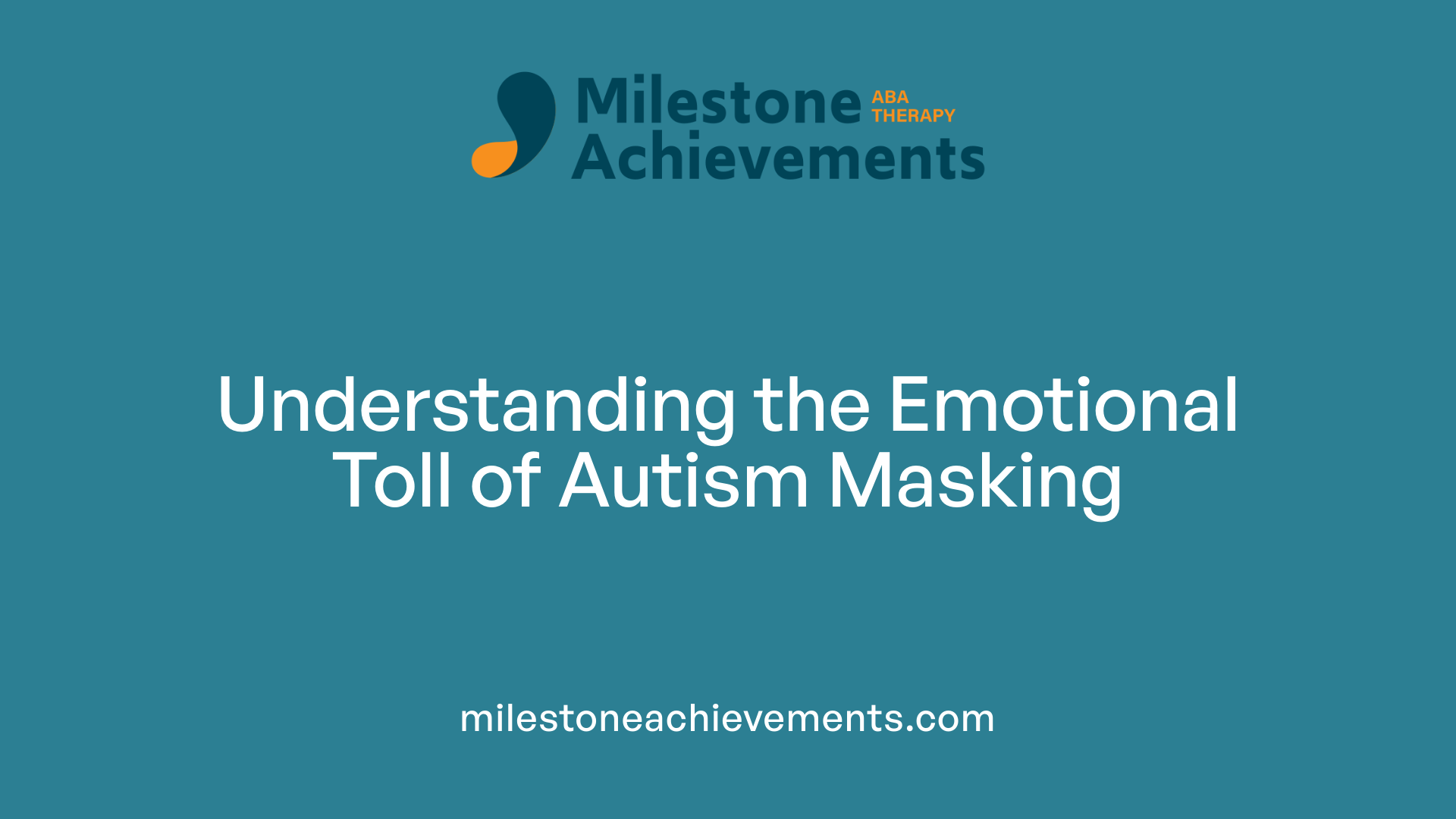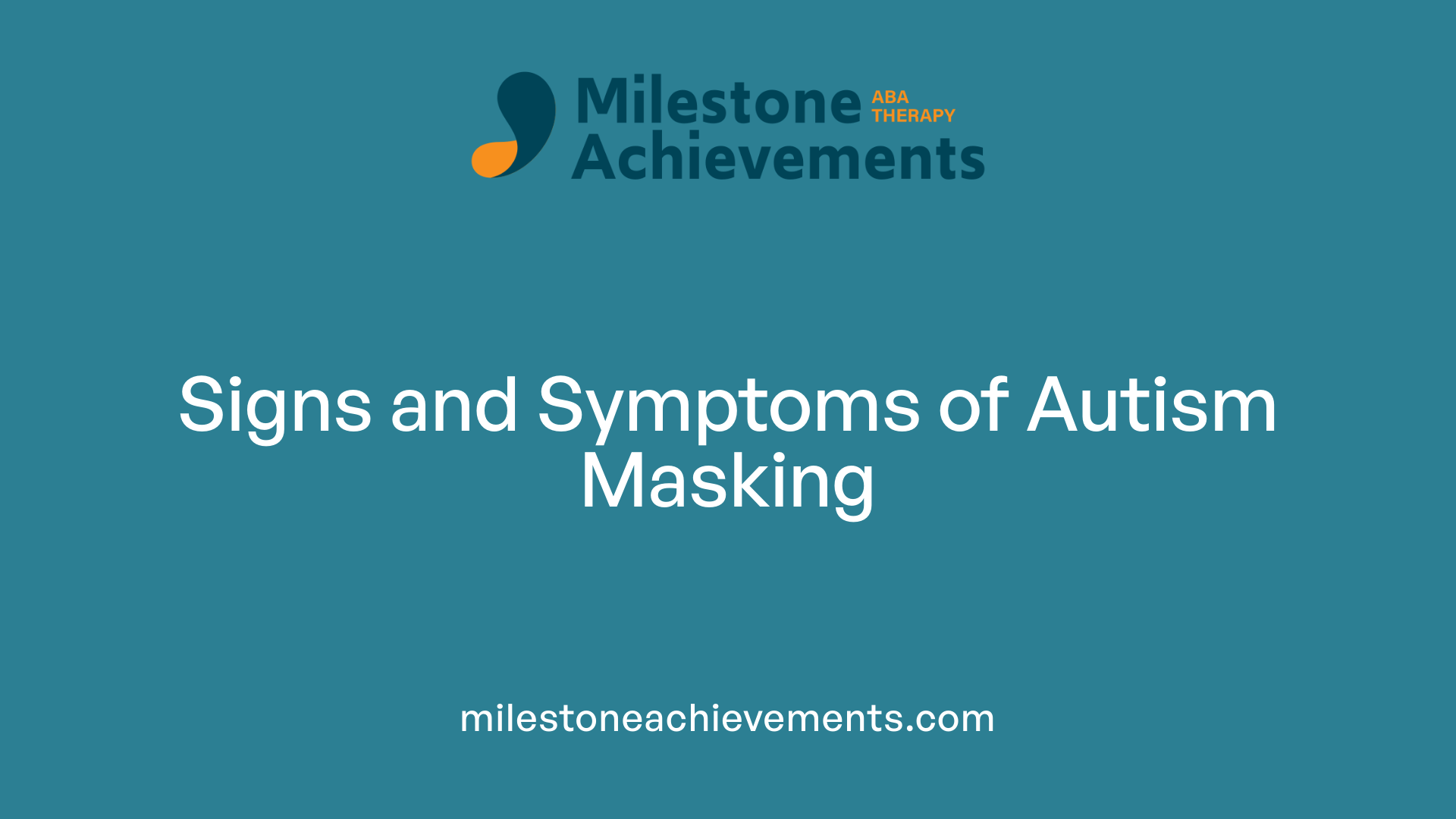
What Is Autism Masking
Unveiling the Mask: Understanding Autism Masking and Its Impacts
Introduction to Autism Masking and Its Significance
Autism masking, also known as camouflaging, is a complex phenomenon where autistic individuals consciously or unconsciously alter or hide their natural behaviors to appear more neurotypical. This adaptive strategy is often driven by social, cultural, and environmental pressures and serves as a means to navigate a world that frequently misunderstands or stigmatizes neurodivergence. While masking might temporarily facilitate social acceptance and safety, it carries profound implications for mental health, diagnosis, and personal authenticity. This article delves into the intricacies of autism masking, exploring how it manifests, why individuals engage in it, its effects, and ways to foster environments that support true self-expression.
What Is Autism Masking and How Does It Manifest?
What is autism masking and how does it manifest?
Autism masking, also known as camouflaging, is a behavior where autistic individuals consciously or unconsciously hide or imitate social traits to appear more neurotypical. This strategy helps them navigate societal expectations and reduce the risk of judgment or rejection.
Masked behaviors often include mimicking facial expressions and body language, maintaining eye contact even if uncomfortable, rehearsing responses in social conversations, and suppressing typical autistic behaviors such as stimming—like hand-flapping or rocking.
People who mask also adjust their speech patterns, tone, and volume to align with social norms. They may develop scripts for common social situations, rehearsing what to say or do in advance. Additionally, behaviors like avoiding passionate topics or overly helpful actions are common tactics to blend into social groups.
This process can be highly effortful, requiring significant energy and concentration. It often results in emotional exhaustion, stress, and even burnout. Many individuals report feeling a disconnect from their true selves, leading to feelings of loss of identity and increased mental health challenges such as anxiety and depression.
Reasons behind masking include a desire to gain acceptance, avoid stigma, prevent bullying, or succeed socially and professionally. While masking may improve short-term social interactions and safety, it can also delay diagnosis or access to support, as symptoms are hidden or minimized.
Supporting autistic individuals involves fostering understanding, acceptance, and accommodations. Recognizing masking behaviors is crucial for promoting mental well-being and ensuring support systems that respect authentic self-expression.
Signs and Symptoms of Autism Masking
What are signs and symptoms of autism masking?
Signs and symptoms of autism masking include displaying highly polished social interactions and mimicking social behaviors to appear neurotypical. Individuals may suppress natural behaviors such as stimming, camouflage sensory sensitivities, or rely on learned scripts during conversations. They often invest extensive mental effort in preparing for social situations, leading to feelings of exhaustion afterward.
Masking can also involve studying social cues and consciously managing facial expressions and gaze to avoid misinterpretation. Over time, sustained masking may result in emotional fatigue, increased anxiety or depression, and difficulty recognizing or expressing their authentic self.
Observable indications of masking
Autistic individuals who mask might appear to behave like their neurotypical peers in social settings. Some common observable indicators include:
- Maintaining eye contact, even when uncomfortable.
- Mirroring body language and facial expressions of others.
- Rehearsing or scripting responses in conversations.
- Suppressing obvious autistic traits like stimming, fidgeting, or sensory reactions.
- Using socially acceptable language or topics and avoiding passionate or sensitive subjects.
Common behaviors and signs
Typical masking behaviors involve চেষ্টা to blend in or appear unaffected by autistic tendencies. These include:
- Mimicking gestures, postures, or speech patterns.
- Creating and rehearsing social scripts to handle conversations.
- Concealing stimming behaviors like hand-flapping or rocking.
- Wearing a facade of confidence, even when feeling overwhelmed or anxious.
- Adjusting speech volume or tone to match surroundings.
Emotional and physical exhaustion signs
The process of masking is energy-consuming and can lead to noticeable signs of burnout:
- Persistent tiredness and fatigue after social interactions.
- Increased anxiety, stress, or feelings of emotional overload.
- Physical symptoms like headaches, muscle tension, or gastrointestinal issues.
- Feelings of detachment from oneself or emotional numbness.
- Withdrawal from social situations once the masking effort becomes too draining.
Recognizing these signs is essential for supporting autistic individuals in reducing reliance on masking and promoting authentic self-expression and mental well-being.
Why Do Individuals Engage in Autism Masking?

Motivations for masking
Autistic individuals often mask to navigate social environments more smoothly. They do this primarily to blend in, aiming to avoid judgment, stigma, or mistreatment. Many suppress behaviors like stimming or intense interests that might stand out, and develop social scripts to converse more naturally. Masking provides a way to appear neurotypical, which can help maintain friendships, succeed professionally, or succeed in social settings.
Environmental and social influences
The environment plays a significant role in prompting masking behaviors. Environments that lack acceptance or understanding of autism, such as schools or workplaces, can pressure individuals to hide their traits. Experiences of bullying, rejection, or discrimination further reinforce these behaviors. Society's often narrow definition of 'normal' amplifies the tendency to mask, especially among females and adolescents, who are socialized to conform more strictly to social norms.
Social pressures and personal reasons
Social pressures are one of the main drivers of masking. Many autistic people learn to mimic neurotypical behaviors to avoid negative reactions and fit in better. Personal reasons also include a desire for safety—avoiding bullying or abuse—and the pursuit of social acceptance. Masking can also be a subconscious coping mechanism developed early in life, often stemming from trauma or harsh reactions to autistic traits. While masking can facilitate social engagement temporarily, it often comes with mental health costs such as anxiety, depression, and a loss of personal authenticity.
| Reason Type | Common Masking Behaviors | Underlying Motivation |
|---|---|---|
| Social acceptance | Mimicking body language, scripted conversations | To be perceived as socially competent |
| Avoiding stigma | Suppressing stimming, hiding interests | To evade negative judgment or discrimination |
| Personal safety | Hiding sensory discomforts, masking reactions | To prevent bullying or abuse |
| Achievement and success | Practicing social cues, using rehearsed responses | To succeed in school, work, or relationships |
Understanding these motivations can promote greater empathy and support for autistic individuals, highlighting the importance of creating accepting environments that reduce the need for masking.
Effects and Impact of Autism Masking on Individuals

What are the effects of autism masking on individuals?
Masking autism involves hiding or modifying natural behaviors to appear more socially typical, often to avoid negative judgment or rejection. This effort can be extremely draining physically and emotionally. Many autistic people report feeling constantly fatigued due to the high cognitive load of monitoring and adjusting their behaviors.
The sustained effort to mask can result in burnout — emotional, mental, and sometimes physical exhaustion that impairs daily functioning. Over time, individuals may develop mental health challenges such as anxiety, depression, and even suicidal thoughts. The continuous suppression of natural responses causes a sense of disconnection from oneself, leading to feelings of lost identity and authenticity.
Moreover, masking can significantly delay autism diagnosis, especially in adults and women, making it harder for individuals to access the support they need. The stress and concealment can also foster social isolation, as individuals struggle to find genuine connections while hiding their true selves.
Supporting autistic individuals means fostering societal acceptance and understanding. Creating safe environments that celebrate neurodiversity and encourage authentic self-expression helps reduce the reliance on masking. Education and awareness are crucial in helping communities recognize the emotional toll of masking and promote inclusivity, allowing autistic people to live more openly and comfortably.
When Does Autism Masking Typically Begin?
Age of onset for masking behaviors
Autism masking generally begins in early childhood but does not have a specific age for everyone. Many autistic children start to develop masking behaviors between the ages of 4 and 6. This is often when they enter preschool and become more exposed to social expectations and peer interactions.
Developmental stages and social pressures
As children grow, social environments become more complex, especially during puberty and adolescence. During these stages, the pressure to conform and avoid negative reactions increases. Autistic individuals may consciously or unconsciously start to mask more to fit in and navigate social norms.
Early signs of masking
Recognizable early signs include mimicking peers’ behaviors, forcing eye contact, scripting conversations, and suppressing behaviors like stimming. These behaviors often develop as coping mechanisms as children become more aware of social expectations.
| Development Stage | Typical Masking Behaviors | Influencing Factors |
|---|---|---|
| Preschool (ages 4-6) | Copying peer actions, avoiding overt autistic behaviors | Social environment, early social experiences |
| Childhood | Developing social scripts, suppressing stimming | Peer acceptance, school environment |
| Adolescence | Intensive masking, hiding interests, mimicking social cues | Cultural expectations, desire for independence |
| Adulthood | Maintaining masking, managing stress | Career, relationships, social stigma |
Understanding when masking begins involves recognizing that it starts early, often as children try to hide their differences to avoid rejection. The developmental timing varies among individuals but generally becomes more pronounced during the adolescent years due to increased social pressures.
How Can You Recognize if Someone is Masking Autism?

Behavioral cues indicating masking
Individuals who mask autism often display certain behavioral signs that suggest they are concealing their natural traits. These include consistently suppressing behaviors like stimming — such as hand-flapping, rocking, or finger-tapping — which are common self-regulatory actions for autistic people. They might also mimic social cues that do not feel natural, like maintaining eye contact despite discomfort or copying body language of others to appear more typical.
Other common signs involve scripting conversations, rehearsing responses, or choosing topics they believe are socially acceptable instead of engaging in spontaneous dialogue. They may behave overly helpful or agreeable and avoid behaviors that might set them apart, like expressing passionate interests or reacting strongly to sensory stimuli.
Internal signs and emotional states
Internally, many autistic maskers experience feelings of high stress and anxiety. Despite appearing to function smoothly, they often report feeling overwhelmed or emotionally exhausted after social interactions. Many have internal distress related to the effort of constantly monitoring their behavior to fit societal expectations.
These individuals might also report feelings of dissatisfaction, confusion about their own identity, or a sense of disconnection from their authentic selves. Recognizing these internal signs can be crucial to understanding the true emotional cost of masking.
Assessment of exhaustion and anxiety
Physical signs such as frequent fatigue, difficulty sleeping, headaches, or muscle tension are common among those who mask autism. Chronic exhaustion may indicate prolonged camouflage efforts, especially in environments that demand social conformity.
Mentally, heightened anxiety, racing thoughts, or feelings of panic in social settings can point toward masking behaviors. These signs often go unnoticed but are significant indicators of the emotional toll masking can take.
By paying close attention to these behavioral and internal cues, friends, family members, and professionals can better recognize when someone might be masking their autism. Supporting them involves creating safe, accepting environments where they feel comfortable being authentic without the need to hide or suppress their natural behaviors.
Examples of Autism Masking Behaviors

What are some examples of autism masking behaviors?
Autistic masking behaviors are actions that individuals use to conceal their natural traits and blend in with neurotypical social norms. These include changing or controlling their speech patterns, such as modulating tone of voice or using scripted phrases during conversations. Many autistic people suppress behaviors like hand-flapping or rocking—known as stimming—to avoid attracting attention.
A common strategy is mimicking social cues, like copying facial expressions, gestures, and body language seen in others. Maintaining eye contact, even if uncomfortable, is another frequent masking behavior. Additionally, some develop rehearsed responses or adopt socially acceptable topics of interest to seem more engaged.
These actions often occur unconsciously as a way to reduce social rejection or bullying. While they can improve social acceptance temporarily, they demand a lot of mental and physical energy, which can result in exhaustion, increased anxiety, and difficulty in expressing authentic feelings.
Is Masking Only for Autism? Broader Context of Masking in Neurodiversity
Is masking only for autism, or do other conditions involve masking?
Masking is not exclusive to autism; it extends to a variety of neurodivergent conditions where individuals hide or control their traits to navigate social environments. People with Attention Deficit Hyperactivity Disorder (ADHD), sensory processing disorder, and some mood or anxiety disorders may also engage in masking behaviors.
Common masking strategies include mimicking social cues, suppressing natural responses, or establishing routines that help them appear more typical in social settings. For example, someone with ADHD might hide signs of impulsivity, while a person with sensory sensitivities might mask discomfort by pretending everything is fine.
While masking can temporarily facilitate social interactions and reduce stigma, it often leads to negative mental health outcomes such as increased stress, anxiety, exhaustion, burnout, and feelings of disconnection from one’s authentic self.
Understanding that masking occurs across various conditions emphasizes the importance of fostering acceptance for all neurodiverse individuals. Reducing societal pressures to conform and promoting environments where people feel safe to express their true selves can significantly lessen the need to mask and its associated harms.
Shared masking behaviors
Masking behaviors tend to be similar regardless of the specific condition, including:
- Copying social behaviors and mannerisms
- Suppressing sensory overload reactions or stimming
- Developing and rehearsing scripts for conversations
- Avoiding behaviors deemed socially unacceptable
- Masking internal discomfort or emotional responses
These strategies are often learned over time and can be both conscious and unconscious. They serve as survival mechanisms to avoid judgment, marginalization, or discrimination.
Implications of masking beyond autism
Masking impacts individuals’ mental health, well-being, and social experiences outside of autism. It can delay diagnoses and access to support because symptoms are hidden.
Moreover, persistent masking can cause significant psychological stress, leading to burnout or crises such as depression and suicidal ideation.
Recognizing masking as a shared behavior among various neurodiverse groups broadens the conversation around acceptance and accommodations. It highlights the importance of societal change — fostering environments where neurodiverse people can be themselves without fear of stigma or prejudice.
| Condition | Masking Behaviors | Common Motivations | Potential Consequences |
|---|---|---|---|
| Autism | Suppressing stims, scripting | Acceptance, safety | Burnout, delayed diagnosis |
| ADHD | Hiding impulsiveness | Social acceptance | Anxiety, exhaustion |
| Sensory Disorders | Masking discomfort | Avoiding discomfort, stigma | Social withdrawal, stress |
| Mood Disorders | Concealing emotional states | Social norms, stigma | Isolation, worsening symptoms |
Understanding the broader scope of masking helps promote empathy and more effective support strategies for all neurodiverse individuals.
Special Considerations for Women and Girls in Autism Masking
Are there specific considerations regarding autistic masking in women and girls?
Autistic women and girls often engage in masking behaviors more frequently than their male counterparts. This tendency is influenced by societal expectations and gender norms that encourage women and girls to appear socially compliant and emotionally controlled.
To blend in, they may develop complex strategies such as rehearsing social scripts, mimicking neurotypical behaviors, and suppressing typical autistic traits like stimming. Many hide their intense interests or hide sensory sensitivities to avoid standing out.
Masking can be both a conscious decision and an unconscious habit, involving significant mental effort. This can result in high levels of exhaustion, chronic stress, and mental health problems such as anxiety and depression.
Because masking often conceals their true behaviors and feelings, diagnosis can be delayed or missed entirely. Healthcare professionals may mistake masked autistic traits for typical social behaviors, making it harder to recognize autism in women and girls.
Understanding these gender-specific masking behaviors is vital for improving diagnosis accuracy. It also emphasizes the need for supportive environments that recognize and accept diverse expressions of autism, free from pressure to conform or mask.
Fostering Acceptance and Supporting Masking Individuals

Creating supportive environments
Fostering an inclusive and understanding atmosphere is crucial in helping autistic individuals feel safe and valued without the need to mask their traits. Environments that celebrate neurodiversity and respect individual differences reduce the pressure to conform to neurotypical standards. This includes implementing autism-friendly practices such as sensory-friendly spaces, flexible communication methods, and accepting stimming behaviors, which are often suppressed by masking. Schools, workplaces, and community spaces can promote awareness campaigns to educate others about autism and celebrate diverse behaviors, encouraging authenticity.
Role of community and professionals
Community support and professional guidance play significant roles in reducing the reliance on masking. Support groups and community initiatives provide safe spaces for autistic people to share experiences and learn from others. Professionals trained in neurodiversity and the social model of autism can assist individuals in developing self-acceptance and resilience. Counseling, peer mentoring, and autism-friendly therapy approaches help individuals manage the emotional exhaustion linked to masking, encouraging genuine self-expression and mental well-being.
Strategies to reduce masking risks
Reducing the need to mask involves empowering autistic individuals with practical tools and supportive policies. Encouraging the practice of safe stimming, advocating for accommodations in educational and workplace settings, and fostering open communication about sensory and social needs can help. Teaching self-advocacy, helping develop simple social scripts, and promoting self-compassion strategies enable individuals to navigate social interactions more comfortably without excessive masking. Overall, creating environments where authenticity is accepted can significantly lessen the mental health risks and enhance quality of life for autistic people.
Conclusion: Embracing Authenticity for Better Well-Being
Understanding autism masking is vital for fostering a more inclusive, compassionate society that recognizes and accepts the spectrum of neurodivergent experiences. While masking may offer short-term social benefits, its long-term toll on mental health and personal identity cannot be overlooked. By increasing awareness of the signs, causes, and effects of masking, and by creating environments that support authentic self-expression, we can help autistic individuals lead healthier, more fulfilling lives. Emphasizing acceptance, understanding, and tailored support strategies are key steps toward reducing the need for masking and promoting true neurodiversity.
References
- Masking - National Autistic Society
- Autism Masking Is Common. Here's How To Recognize And Offer ...
- Autistic masking - Wikipedia
- Autistic people and masking - National Autistic Society
- A Conceptual Analysis of Autistic Masking: Understanding the ...
- “Masking” in Individuals with Autism Spectrum Disorder
- Masking when you're autistic | Autism Space
- What is Masking in Autism? Autistic Masking Explained
- Camouflage and masking behavior in adult autism - PMC
- What are the main signs of autism masking in women?


Partner with us on your child's journey
Milestone Achievements offers evidence-based ABA therapy to help children with autism reach their full potential. Together we’ll set meaningful goals and celebrate progress every step of the way.
Start ABA Services Today


